ESP AUDI A6 2014 Owner's Guide
[x] Cancel search | Manufacturer: AUDI, Model Year: 2014, Model line: A6, Model: AUDI A6 2014Pages: 304, PDF Size: 76.32 MB
Page 127 of 304
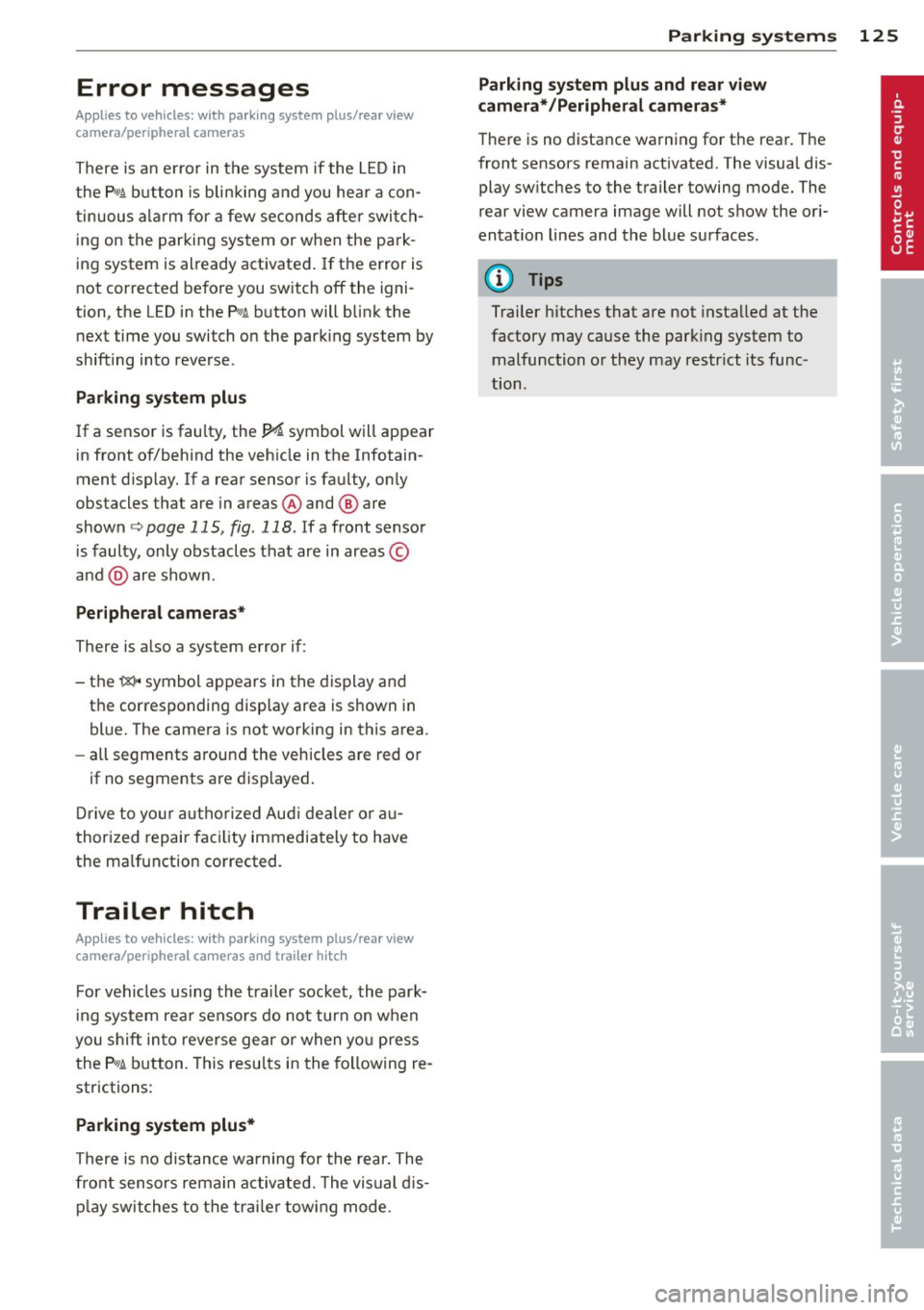
Error messages
Applies to vehicles: with parking system plus/rear view
camera/per ipheral cameras
There is an e rror in the system if the LED in
the
p, qA button is blinking and you hear a con
tinuous alarm for a few seconds afte r switch
ing on the parking system or when the park
ing system is already activated. If the error is
not corrected before you switch off the igni
tion, the LED in the
Pw.6. button will blink the
next time you switch on the parking system by
shifting into reverse.
Parking system plus
If a sensor is faulty, the~ symbol will appear
in front of/behind the vehicle in the Infotain
ment display. If a rear sensor is fau lty, only
obstacles that are in areas @ and @ are
shown ¢
page 115, fig. 118. If a front sensor
i s faulty, only obstacles that are in areas ©
and @are shown .
Peripheral cameras*
There is also a system error if:
- the
'(:8:)• • symbol appears in the display and
the corresponding display area is shown in
blue. The camera is not working in this area.
- all segments around the vehicles are red or
if no segments are displayed.
Drive to your authorized Aud i dea ler o r au
thorized repair fac ility immediately to have
the ma lfunction corrected.
Trailer hitch
Appl ies to vehicles: with parking system plus/rear view
camera/per ipheral cameras and trailer hitch
For vehicles using the tra iler socket, the park
ing system rear senso rs do not turn on when
you shift into reverse gear or when yo u press
the P
01A button. This results in the following re
strictions:
Parking system plus*
There is no distance wa rning for the rear. The
front sensors rema in activated. The visual dis
play switches to the traile r tow ing mode.
Parking systems 125
Parking system plus and rear view
camera* /Peripheral cameras*
There is no distance warning for the rear. The
front sensors remain activated. The visual dis
play sw itches to the trailer towing mode. The
rear view camera image will not show the ori
entation lines and the blue surfaces .
{D Tips
Trailer hitches that are not installed at the
factory may cause the park ing system to
malfunction or they may restr ict its func
tion.
Page 130 of 304
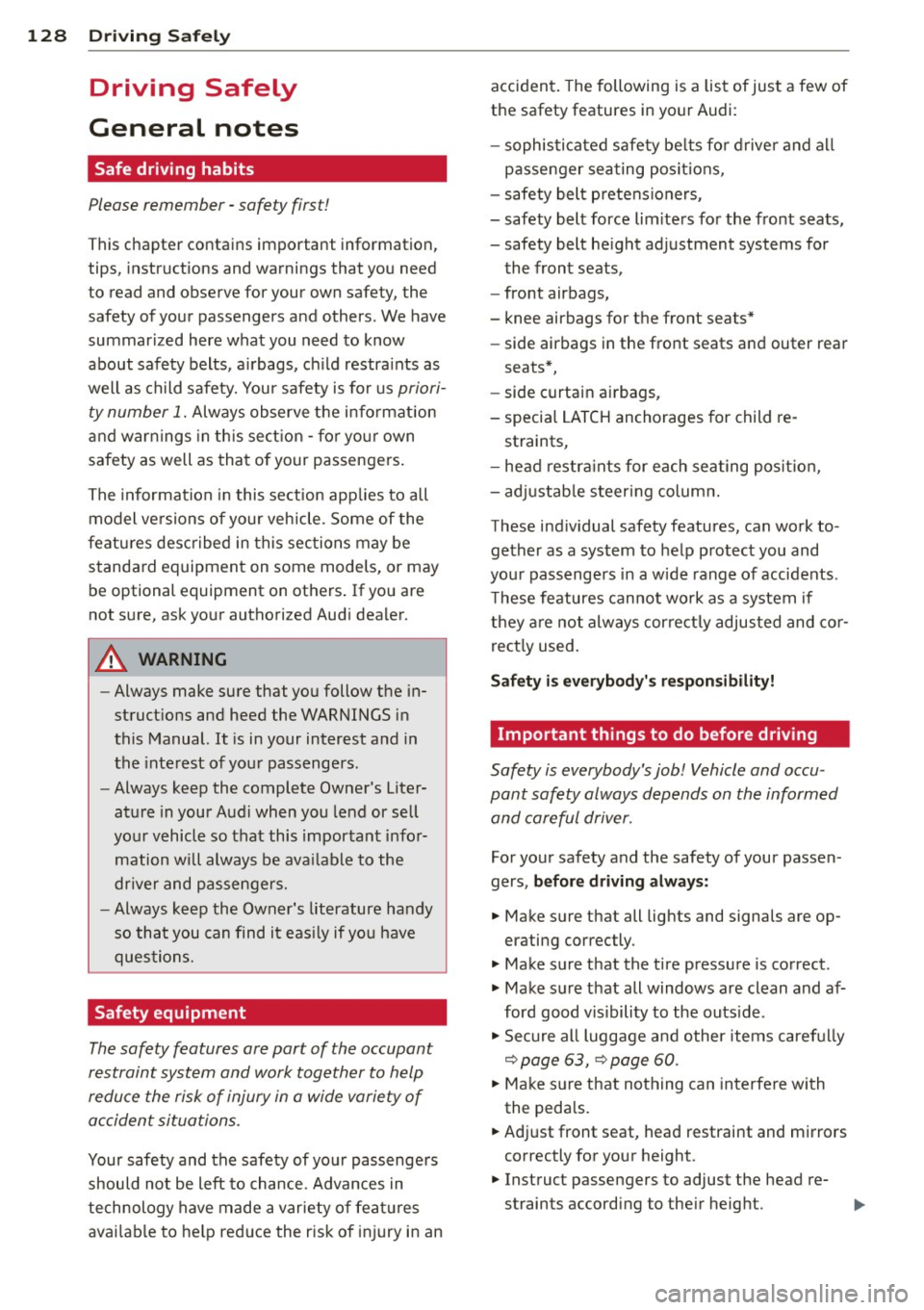
128 Driving Safely
Driving Safely
General notes
Safe driving habits
Please remember -safety first!
This chapter contains important information,
tips, instructions and warnings that you need
to read and observe for your own safety, the
safety of your passengers and others . We have
summarized here what you need to know
about safety belts, airbags, child restraints as
well as child safety. Your safety is for us
priori
ty number 1.
Always observe the information
and warnings in this section - for your own
safety as well as that of your passengers.
The information in this section applies to all
model versions of your vehicle . Some of the
features described in this sections may be
standard equipment on some models, or may
be optional equipment on others. If you are
not sure, ask your authorized Audi dealer.
A WARNING
- Always make sure that you follow the in
structions and heed the WARNINGS in
this Manual. It is in your interest and in
the interest of your passengers.
- Always keep the complete Owner's Liter
ature in your Audi when you lend or sell
your vehicle so that this important infor
mation will always be available to the
driver and passengers.
- Always keep the Owner's literature handy
so that you can find it easily if you have
questions.
Safety equipment
The safety features are part of the occupant
restraint system and work together to help
reduce the risk of injury in a wide variety of
accident situations.
Your safety and the safety of your passengers
should not be left to chance. Advances in
technology have made a variety of features
available to help reduce the risk of injury in an accident.
The following is a list of just a few of
the safety features in your Audi:
- sophisticated safety belts for driver and all
passenger seating positions,
- safety belt pretensioners ,
- safety belt force limiters for the front seats,
- safety belt height adjustment systems for
the front seats,
- front airbags,
- knee airbags for the front seats*
- side airbags in the front seats and outer rear
seats*,
- side curtain airbags ,
- special LATCH anchorages for child re-
straints,
- head restraints for each seating position,
- adjustable steering column.
These individual safety features, can work to gether as a system to help protect you and
your passengers in a wide range of accidents .
These features cannot work as a system if
they are not always correctly adjusted and cor
rectly used.
Safety is everybody's responsibility!
Important things to do before driving
Safety is everybody 's job! Vehicle and occu
pant safety always depends on the informed and careful driver .
For your safety and the safety of your passen
gers,
before driving always:
.. Make sure that all lights and signals are op
erating correctly.
.. Make sure that the tire pressure is correct .
.. Make sure that all windows are clean and af
ford good visibility to the outside .
.. Secure all luggage and other items carefully
q page 63, q page 60 .
.. Make sure that nothing can interfere with
the pedals.
.. Adjust front seat, head restraint and mirrors
correctly for your height.
.. Instruct passengers to adjust the head re-
straints according to their height . .,..
Page 131 of 304
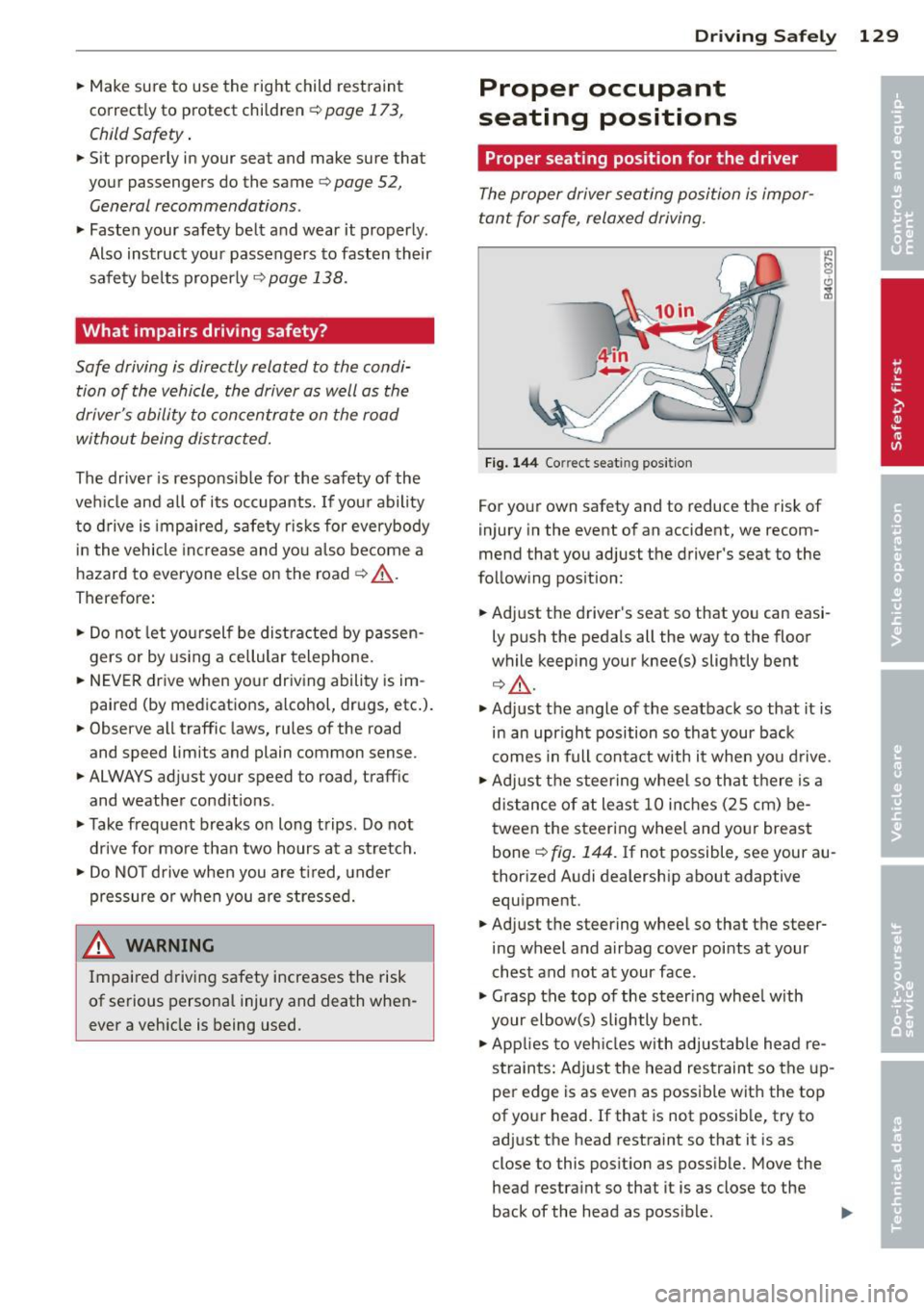
.. Make sure to use the right child rest raint
correct ly to protect children
Q page 173,
Child Safety .
.. Sit properly in your seat and make sure that
your passengers do the same¢
page 52,
General recommendations .
.. Fasten your safety belt and wear it properly.
Also instruct your passengers to fasten their
safety belts properly ¢
page 138.
What impairs driving safety?
Safe driving is directly related to the condi
tion of the vehicle, the driver as well as the
driver 's ability to concentrate on the road
without being distracted.
The driver is respons ible for the safety of the
veh icle and all of its occupants.
If your ability
to drive is impai red, safety r isks for everybody
in the vehicle increase and you also become a
hazard to everyone else on the road ¢
A.
Therefore:
.. Do not let yourself be distracted by passen
gers or by using a cellular telephone.
.. NEVER drive when your driving ability is im
paired (by medications, alcohol, drugs, etc .).
.. Observe all traffic laws, rules of the road
and speed limits and plain common sense .
.. ALWAYS adjust your speed to road, traff ic
and weather conditions .
.,. Take frequent breaks on long trips. Do not
drive for more than two hours at a stretch.
.. Do NOT drive when you are t ired, under
pressure or when you are stressed.
A WARNING
Impaired driving safety increases the risk
of serious personal injury and death when
ever a vehicle is being used.
Driving Safely 129
Proper occupant
seating positions
Proper seating position for the driver
The proper driver seating position is impor
tant for safe, relaxed driving .
Fig. 144 Correct seat ing pos it ion
For your own safety and to reduce the risk of
injury in the event of an accident, we recom
mend that you adjust the driver's seat to the
follow ing pos ition:
.. Adjust the driver's seat so that you can easi
ly push the pedals all the way to the floor
wh ile keeping your knee(s) slightly bent
¢.&_ .
.. Adjust the angle of the seatback so that it is
in an upr ight position so that your back
comes in full contact with it when you drive.
.. Adjust the steering wheel so that th ere is a
distance of at least 10 inches (25 cm) be
tween the steering wheel and yo ur breast
bone
Q fig. 144. If not possible, see your au
thorized Audi dealership about adaptive
equipment .
.. Adjust the steering wheel so that the steer
ing wheel and airbag cover points at your
chest and not at your face.
.,. Grasp the top of the steering wheel with
your elbow(s) slightly bent.
.. App lies to veh icles with adjustable head re
s tra ints: Ad just the head restraint so the up
per edge is as even as possible with the top
of your head. If that is not possible, try to
adjust the head restraint so that it is as
close to this pos it ion as possible. Move the
head restra int so that it is as close to the
back of the head as poss ible. .,.
Page 134 of 304
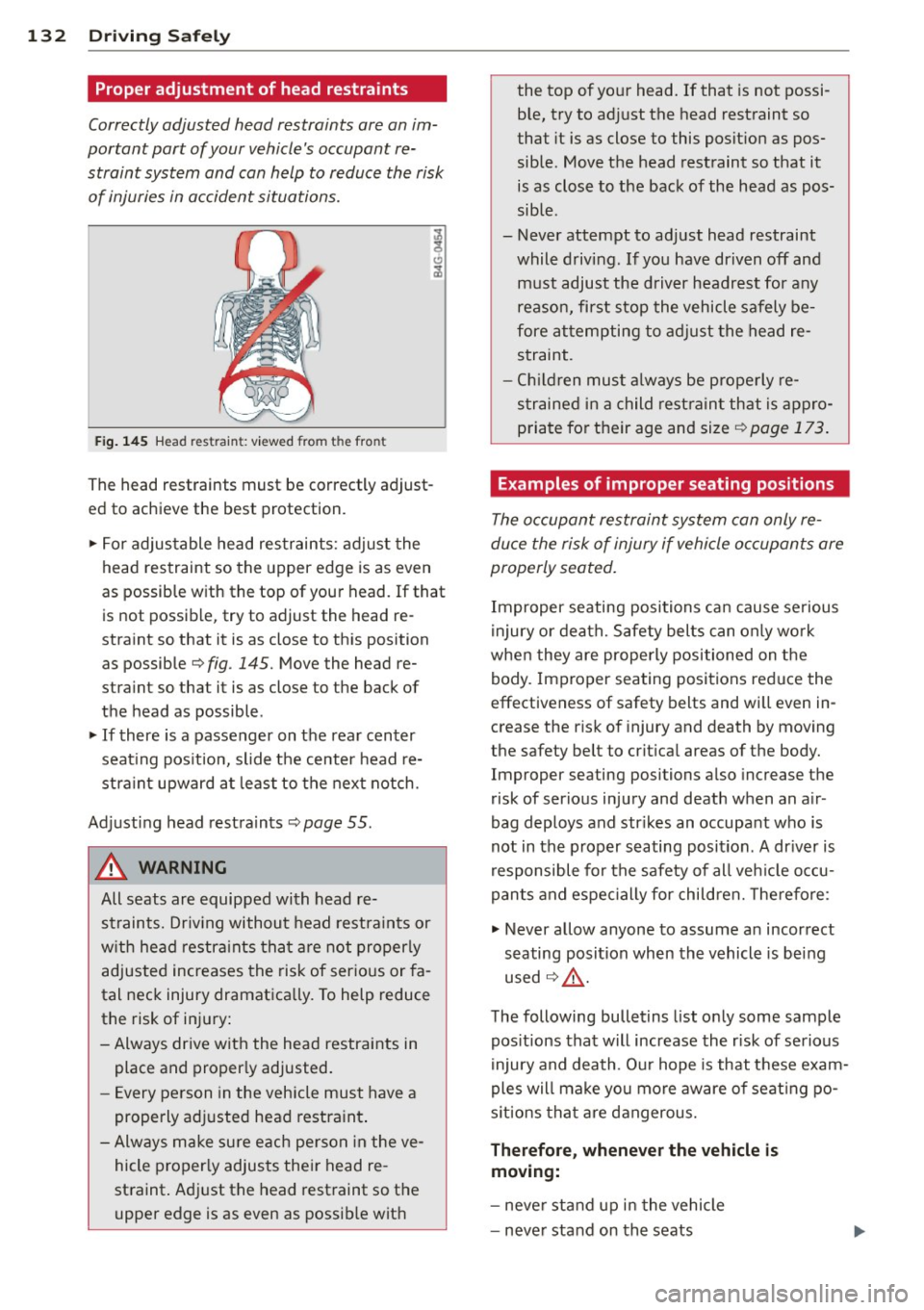
132 Driving Safel y
Proper adjustment of head restraints
Correctly adjusted head restraints are an im
portant part of your vehicle's occupant re
straint system and can help to reduce the risk
of injuries in accident situations.
Fig . 145 H ead restraint: viewed from the front
The head restraints must be correctly adjust
ed to achieve the best protection.
i,.. For adjustable head restraints: adjust the
head restraint so the upper edge is as even
as possible with the top of your head. If that
is not possible, try to adjust the head re
stra int so that it is as close to this position
as possible ¢
fig. 145. Move the head re
stra int so that it is as close to the back of
the head as possible .
i,.. If there is a passenger on the rear center
seat ing pos ition, slide the center head re
stra int upward at least to the next notch.
Adjust ing head restraints¢
page 55.
A WARNING
All seats are equipped with head re
straints. Dr iv ing without head restraints or
w ith head restra ints tha t are not properly
adjusted increases the risk of ser io us or fa
tal neck injury dramatically. To help reduce
the risk of injury:
- Always drive with the head restraints in
place and proper ly adjusted.
- Every pe rson in the vehicle must have a
properly ad justed head restra int .
- Always make su re each pe rson in the ve
hicle proper ly adjusts the ir head re
straint . Ad just the head restraint so the
upper edge is as even as possib le with the top of yo
ur head. If that is not possi
ble, t ry to ad just the head restraint so
that it is as close to this position as pos
sible. Move the head rest raint so that it
is as close to the back of the head as pos
sible.
- Never attempt to adjust head restraint
while driving. If you have driven off and m ust adjust the driver headrest for any
reason, first stop the vehicle safely be
fore at tempting to a djust the head re
straint.
- Ch ild ren mus t always be prope rly re
s trained in a child rest rain t that is appro
p ria te fo r their age and size ¢
page 173.
Examples of improper seating positions
The occupant restraint system can only re
duce the risk of injury if vehicle o ccupants are
properly seated.
Improper seating positions ca n cause serious
injury or death. Safety belts can only wo rk
whe n they are properly positioned on the
body. Improper seating positions reduce the
effectiveness of safety belts and will even in
crease the risk of injury and death by moving
the safety belt to crit ica l areas of the body.
Improper seating positions also increase the
risk of serious injury and death when an air
bag deploys and str ikes an occupant who is
not in the p roper s eating position. A dr iver is
r esponsible fo r the safety of all veh icle occu
pants and espe cially for child ren. The re fore:
i,.. Never allow anyone to assume an incorrect
seating position when the vehicle is being
used ¢& .
The following bullet ins list o nly some sample
pos itions that will increase the r isk of serious
injury and death. Our hope is that t hese exam
ples will make yo u more aware o f seat ing po
s it ions tha t are dangerous.
Therefore , whenever the vehicle is
moving:
- neve r stand u p in the vehicle
- neve r stand on the seats
Page 137 of 304
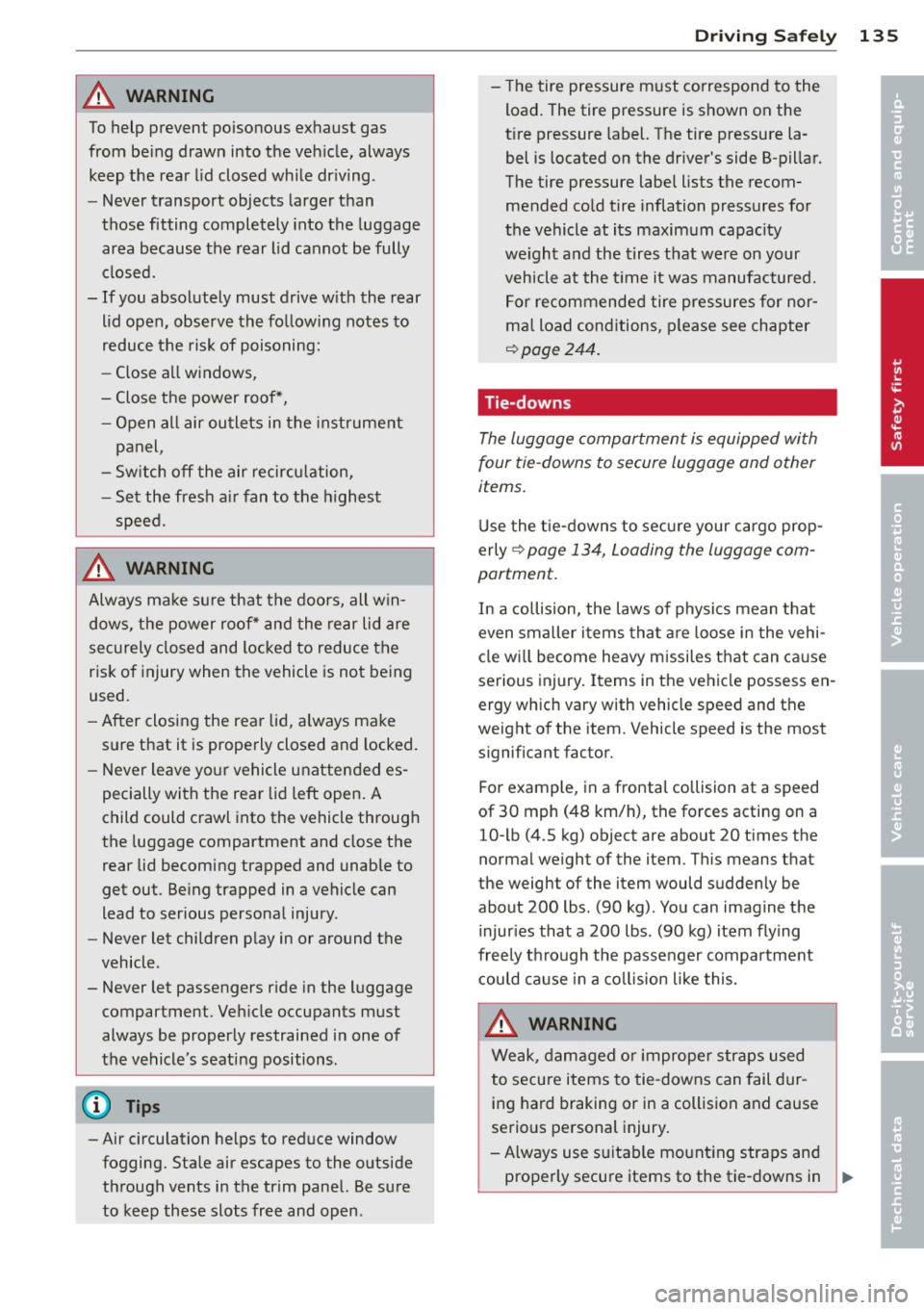
A WARNING
To help prevent poisonous exhaust gas
from being drawn into the vehicle, always keep the rear lid closed while driving .
- Never transport objects larger than
those fitting completely into the luggage
area because the rear lid cannot be fully
closed.
- If you absolutely must drive with the rear
lid open, observe the following notes to
reduce the risk of poisoning:
- Close all windows,
- Close the power roof*,
- Open all air outlets in the instrument
panel,
- Switch off the air recirculation,
- Set the fresh air fan to the highest
speed.
A WARNING
Always make sure that the doors, all win dows, the power roof* and the rear lid are
securely closed and locked to reduce the
risk of injury when the vehicle is not being
used.
- After closing the rear lid, always make
sure that it is properly closed and locked.
- Never leave your vehicle unattended es
pecially with the rear lid left open. A
child could crawl into the vehicle through
the luggage compartment and close the
rear lid becoming trapped and unable to
get out. Being trapped in a vehicle can
lead to serious personal injury.
- Never let children play in or around the
vehicle .
- Never let passengers ride in the luggage
compartment. Vehicle occupants must
always be properly restrained in one of
the vehicle's seating positions.
Gj) Tips
-Air circulation helps to reduce window fogging. Stale air escapes to the outside
through vents in the trim panel. Be sure
to keep these slots free and open .
-
Driving Safely 135
-The tire pressure must correspond to the
load. The tire pressure is shown on the
tire pressure label. The tire pressure la
bel is located on the driver's side B-pillar.
The tire pressure label lists the recom
mended cold tire inflation pressures for
the vehicle at its maximum capacity
weight and the tires that were on your
vehicle at the time it was manufactured. For recommended tire pressures for nor
mal load conditions, please see chapter
~page 244.
Tie-downs
The luggage compartment is equipped with
four tie-downs to secure luggage and other
items.
Use the tie-downs to secure your cargo prop
erly<>
page 134, Loading the luggage com
partment.
In a collision, the laws of physics mean that
even smaller items that are loose in the vehi
cle will become heavy missiles that can cause
serious injury. Items in the vehicle possess en
ergy which vary with vehicle speed and the
weight of the item. Vehicle speed is the most
significant factor.
For example , in a frontal collision at a speed
of 30 mph (48 km/h), the forces acting on a 10-lb (4.5 kg) object are about 20 times the
normal weight of the item. This means that
the weight of the item would suddenly be about 200 lbs. (90 kg) . You can imagine the
injuries that a 200 lbs . (90 kg) item flying
freely through the passenger compartment
could cause in a collision like this.
A WARNING
Weak, damaged or improper straps used
to secure items to tie-downs can fail dur
ing hard braking or in a collision and cause
serious personal injury.
-Always use suitable mounting straps and properly secure items to the tie-downs in
.
•
•
Page 144 of 304
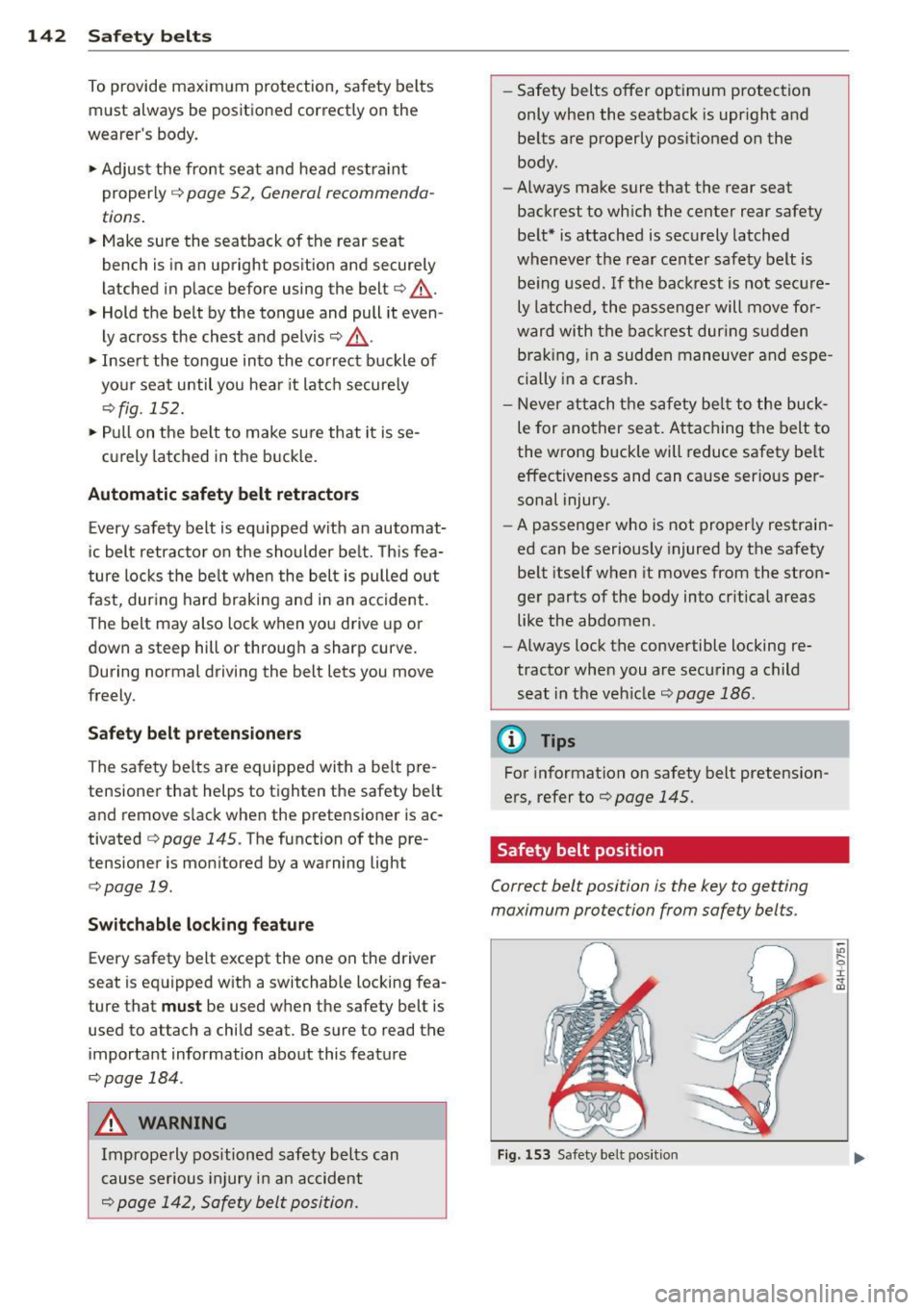
142 Safet y belt s
To provide maximum protection, sa fety belts
must always be positioned correctly on the
wearer 's body .
.,. Adjust the front seat and head restr aint
properly ¢
page 52, General recommenda
t ions .
.,. Make sure the seatback of the rear seat
bench is in an upright pos ition and securely
latched in place before using the belt¢.&,.
.,. Hold the be lt by the tongue and pull it even
ly across the chest and pelvis ¢ .&, .
.,. Insert the tongue into the correct buckle of
yo ur seat until you hea r it latc h securely
¢fig. 152.
.,. Pull on the be lt to make sure that it is se-
curely latched in the buckle.
Automatic safety belt retractors
Every safety belt is equipped w ith an automat
i c belt retractor on the shoulder be lt. This fea
ture locks the be lt whe n the belt is pulled out
fast, during hard braking and i n an accident.
The belt may also lock when you drive up or
down a steep hill or through a sharp curve. During normal driv ing the belt lets you move
freely.
Safety belt preten sione rs
The safety belts are equipped with a be lt pre
tensioner that helps to tighten the safety belt
and remove s lack when the pretensioner is ac
tivated ¢
page 145 . The function of the pre
tensioner is moni tored by a warning light
¢ page 19.
Sw itchabl e lo cking fe atur e
Every safety belt except the one on the driver
seat is eq uipped w ith a switchable locking fea
ture that
m ust be used when the safety belt is
used to attach a child seat. Be sure to read the important information about this feature
¢ page 184 .
.,& WARNING
Improperly positioned safety belts can
cause serious injury in an accident
¢ page 142, Safety belt position.
- Safety belts offer optimum protection
only when the seatback is upright and
belts are properly posit ioned on the
body .
- Always make sure that the rear seat
backrest to which the center rear safety
belt* is attached is securely latched
wheneve r the rea r center safety belt is
being used.
If the backrest is not secu re
ly latched, the passenger will move for
ward with the back rest dur ing sudden
brak ing, in a sudden maneuver and espe
cially in a crash.
- Never at tach the safety bel t to the buck
le for another seat. Attaching the belt to
the wrong buckle will reduce safety be lt
effectiveness and can cause serious per
sonal injury .
- A passenger who is not proper ly restrain
ed can be seriously injured by the safety belt itself when it moves from the stron
ger parts of the body into cr itical areas
like the abdomen .
- Always lock the convertible locking re
tractor when you are securing a child seat in the vehicle ¢
page 186.
(D Tips
For information on safety belt pretension
ers, refer to¢
page 145.
Safety belt position
Correct belt position is the key to getting
maximum protection from safety belts.
F ig. 153 Safety bel t pos it ion
"' .... 0
~ CD
Page 146 of 304
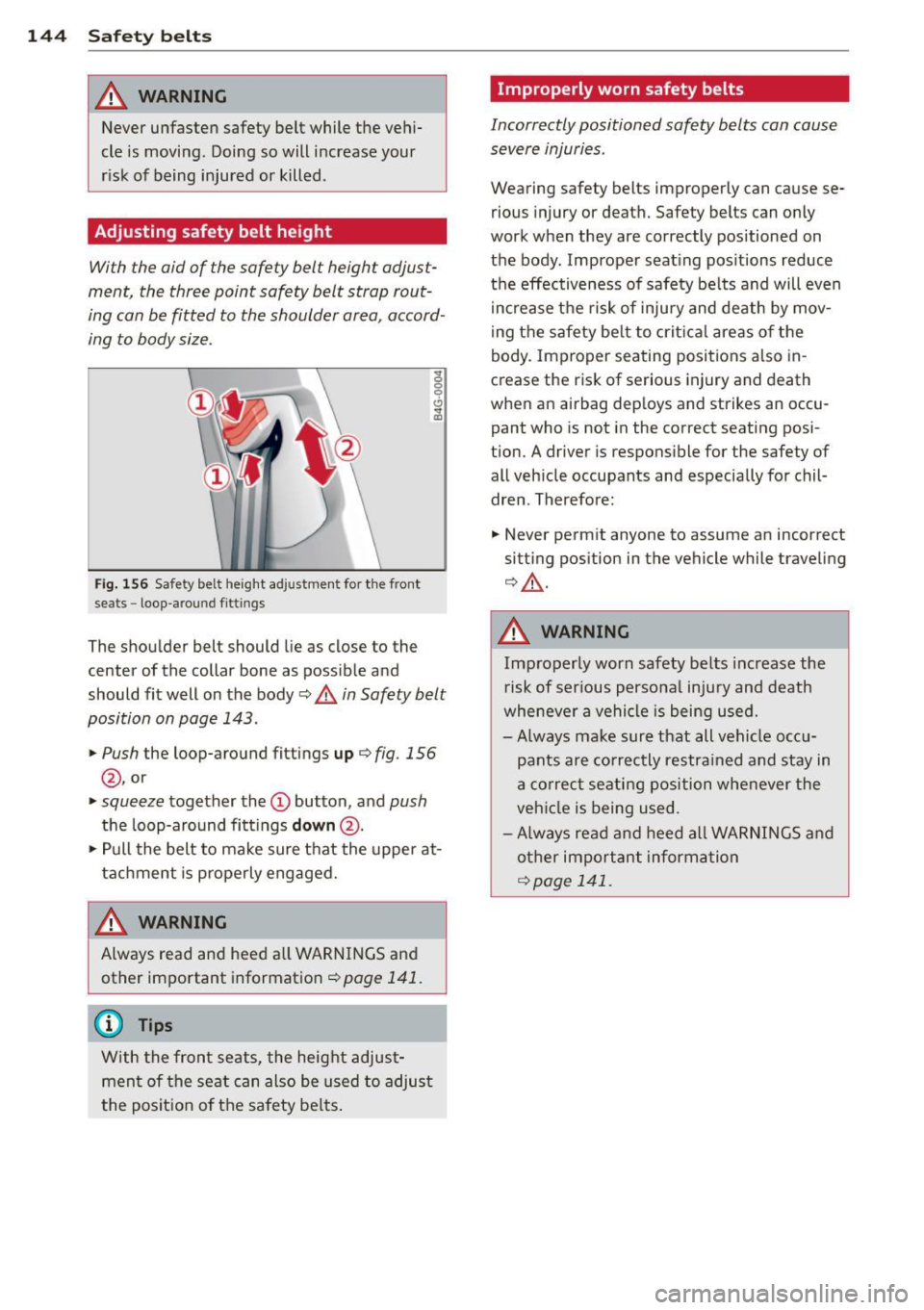
144 Safet y belt s
A WARNING
Never unfasten safety belt while the vehi
cle is moving. Doing so will increase your
r isk of being injured or killed .
Adjusting safety belt height
With the aid of the safety belt height adjust
ment, the three point safety belt strap rout
ing can be fitted to the shoulder area, accord
ing to body size .
Fig. 156 Safety belt height adjustment for the front
sea ts - loop -around f ittings
The shoulder belt should lie as close to the
center of the collar bone as possible and
should fit well on the body¢
A in Safety belt
position on page 143.
,. Push
the loop-around fittings up ¢fig. 156
@ , or
"'"squeeze together the@ button, and push
the loop-around fitt ings down @.
"'" Pull the belt to make sure that the upper at
tachment is p roperly engaged.
A WARNING
Always read and heed a ll WARNINGS and
other important information¢
page 141 .
@ Tips
With the fron t seats, the height adjust
men t of the sea t can also be used to adjus t
the posit ion of the safety be lts.
Improperly worn safety belts
Incorrectly positioned safety belts can cause
severe injuries .
Wearing safety belts improperly can cause se
rious injury or death. Safety belts can o nly
work when they are correctly positioned on
the body . Improper seating pos itions reduce
the effectiveness of safety belts and will even
i ncrease t he risk of injury and death by mov
ing the safety be lt to crit ica l areas o f the
body. Improper seating positions also in
crease the risk of serious injury and death
when an airbag deploys and strikes an occu
pant who is not in the correct seating posi
tion. A driver is respons ible for the safety of
all veh icle occupants and especially for chil
dren . Therefore:
"'" Never permit anyone to assume an incorrect
sitting position in the vehicle while traveling
¢&_ .
A WARNING
Improperly worn safety be lts increase the
r isk of ser ious persona l injury and death
whenever a vehicle is being used.
- Always ma ke sure that all vehicle occ u
pants are co rrectly restra ined and stay in
a correc t seating position whe never the
veh icle is being used .
- Always read and heed all WAR NINGS a nd
o ther important inform ation
¢page 141.
Page 149 of 304
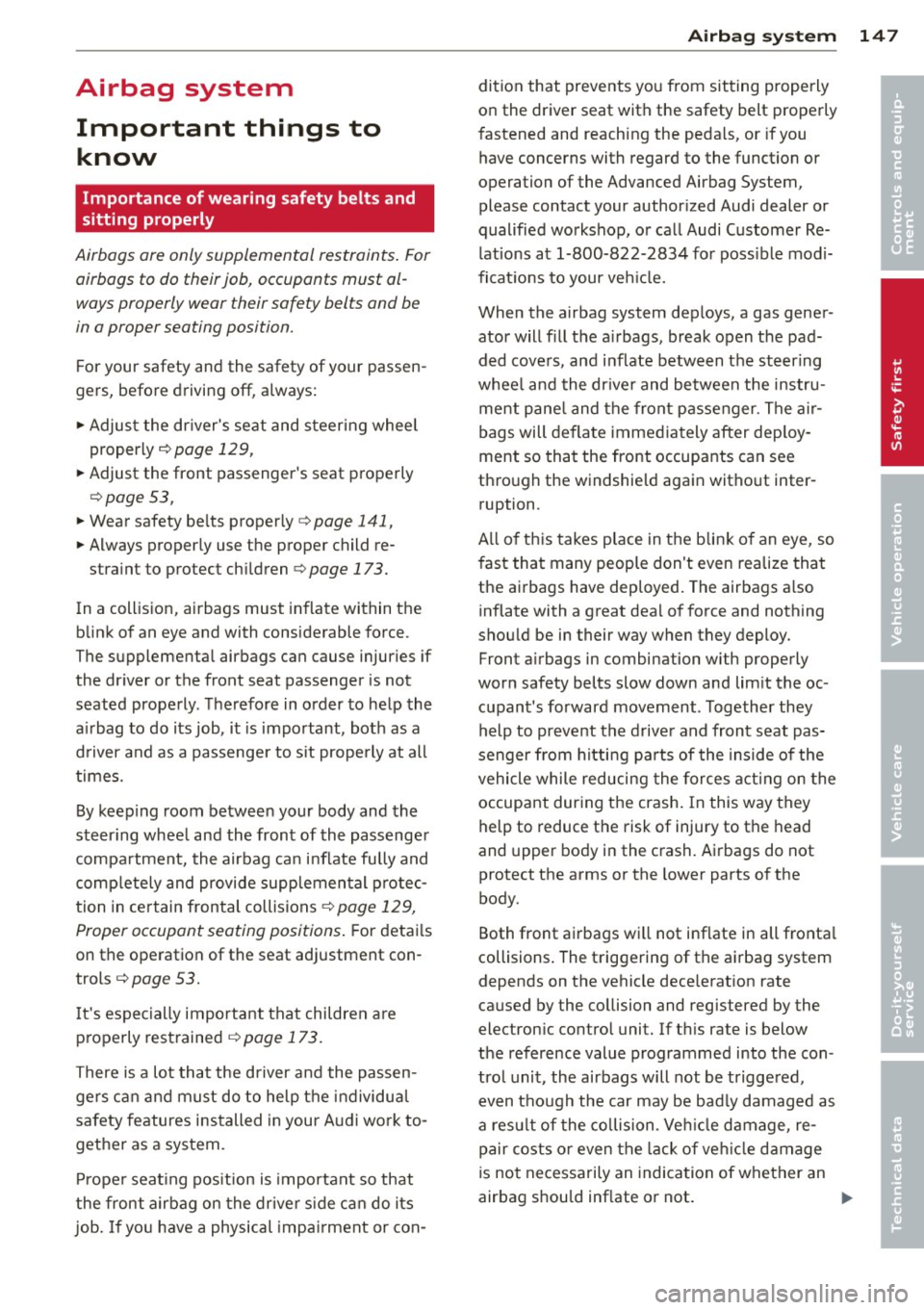
Airbag system Important things to know
Importance of wearing safety belts and
sitting properly
Airbags are only supplemental restraints. For
airbags to do their job, occupants must al
ways properly wear their safety belts and be
in a proper seating position.
For your safety and the safety of your passen
gers, before driving off, always:
"" Adjust the driver's seat and steering wheel
properly¢
page 129,
"" Adjust the front passenger's seat properly
¢ page 53,
""Wear safety be lts properly r::::> page 141,
""Always properly use the proper child re-
straint to protect chi ldren
r::::> page 173.
In a collision, airbags must inflate within the
blink of an eye and with considerable force.
The supplemental airbags can cause injuries if
the driver or the front seat passenger is not
seated properly . T herefore in order to help the
a irbag to do its job, it is important, both as a
driver and as a passenge r to s it properly at all
times.
By keeping room between your body and the
steer ing whee l and the front of the passenger
compartment, the airbag can inflate fully and
comp lete ly and provide supp lemental protec
tion in certain frontal collisions
r::::> page 129,
Proper occupant seating positions.
F or detai ls
on the operation of the seat adjustment con
trols ¢
page 53.
It's especially important that children a re
properly restrained
r::::> page 173.
There is a lot that the driver and the passen
gers can and must do to help the individual
safety features installed in your Aud i work to
gether as a system.
Prope r seat ing pos ition is important so that
the front airbag on the driver side can do its
job. If you have a physical impa irment or con-
A irbag system 147
dition that prevents you from sitting properly
on the driver seat with the safety belt properly
fastened and reaching the pedals, or if you
have concerns with regard to the function or
operation of the Advanced Airbag System,
please contact your author ized Audi dealer or
qualified workshop, or call Audi Customer Re
l ations at 1-800-822-2834 for poss ible modi
ficat io ns to your veh icle.
When the airbag system dep loys, a gas gener
ator will fill the a irbags, break open the pad
ded covers, and inflate between the steer ing
whee l and the dr iver and between the instru
ment panel and the front passenger. The a ir
bags will deflate immediately after dep loy
ment so that the front occupants can see
through the windshield again without inter ruption.
A ll of th is takes place in the blink o f an eye, so
fast that many people don't even realize that
the airbags have deployed. The airbags a lso
inflate with a great dea l of force and nothing
should be in their way when they deploy.
Front a irbags in combination with properly
worn safety belts slow down and lim it the oc
cupant's forward movement. Together they help to prevent the driver and front seat pas
senger from h itti ng pa rts of the inside of the
vehicle while reducing the forces acting on the
occupant during the crash . In this way they
help to reduce the risk of injury to the head
and upper body in the crash. Airbags do not
protect the arms or the lower parts of the
body.
Both front airbags will not inflate in all fronta l
collisions . The triggering of the airbag system
depends on the vehicle dece lerat ion rate
caused by the collision and registered by the
electron ic control unit. If th is rate is below
the reference value programmed into the con
trol unit, the airbags will not be trigge red,
even though the car may be bad ly damaged as
a res ult of the co llision . Ve hicle damage, re
pair costs or even the lack of ve hicle damage
is not necessarily an indication of whether an
airbag should inflate or not . •
•
Page 151 of 304
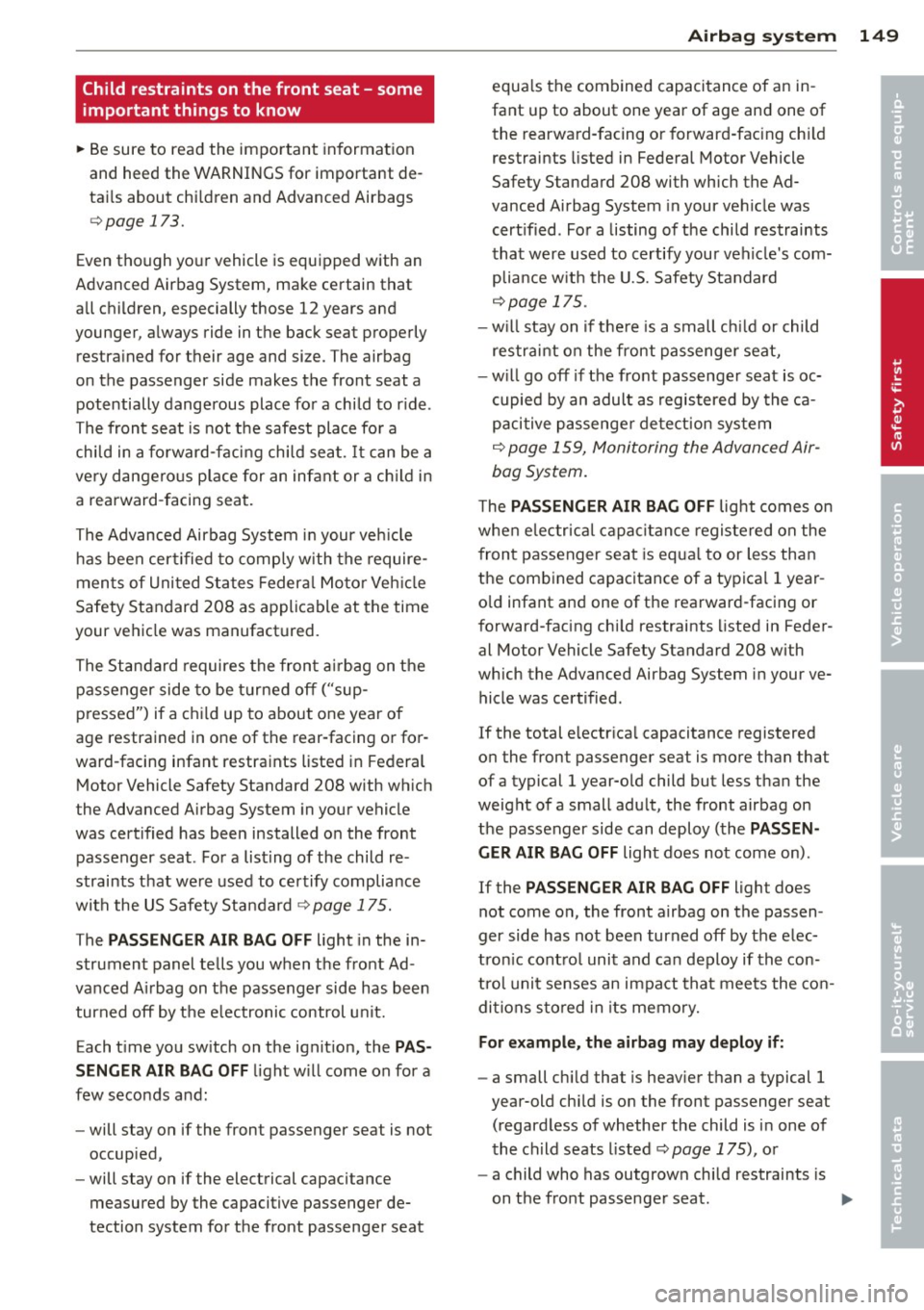
Child restraints on the front seat - some
important things to know
.. Be sure to read the important informat ion
and heed the WARNINGS for important de
tai ls about chi ldren and Advanced Airbags
~ page 173.
Even though your vehicle is equipped with an
Advanced Airbag System, make certain that
a ll chi ldren, especially those 12 years and
younger, a lways ride in the back seat properly
restra ined for their age and si ze. The airb ag
on the passenger side makes the front seat a potentially dangerous place for a child to r ide .
The front seat is not the safest place fo r a
chi ld in a fo rward-facing chi ld seat. It can be a
very dange ro us p lace for an infant or a ch ild in
a rearward -facing seat.
The Advanced Airbag System i n your veh icle
h as been cert ified to comp ly with the require
men ts of Uni ted States Federa l Mo to r Veh icle
Safety Standard 208 as applicable at the time
your vehicle was manufactured.
The Standard requires the front a irbag on the
passenger side to be turne d off ("sup
p ressed") if a chi ld up to about one year of
age restrained in one of the rear -facing or for
ward -facing infant restraints listed i n Federal
Motor Vehicle Safety Standard 208 with wh ich
the Advanced Airbag System in your vehicle
was certified has been installed o n the front
passenger seat . For a listing of the child re
straints that we re used to certify compliance
with the US Safety Standard ~
page 175.
The PASS ENGER AIR BAG OFF light in the in
strument panel te lls you when the front Ad
vanced A irbag on the passenger side has been
turned off by the e lectronic control u nit.
Each t ime you sw itch on the ignit ion, the
PAS
SENGER AIR BAG OFF
l ight w ill come on for a
few seconds a nd:
- will stay on if the front passenger seat is not
occup ied ,
- will stay on if the electrical capacitance
measured by the capacitive passenger de
tection system for the front passenge r seat
A irbag sys tem 149
equa ls the combined capacitance of an in
fant up to about one year of age and one of the rearwa rd-facing o r forward-fac ing ch ild
restraints listed in Federal Motor Vehicle
Safety Standard 208 with which the Ad
vanced Airbag System in your ve hicle was
cert ified . Fo r a listing of the child restraints
that were used to certify your vehicle's com p lia nce w ith the U.S. Safety Standard
~ page 175.
-w ill stay on if t he re is a small ch ild or child
restrai nt on the front passenge r seat,
- w ill go off if the front passenger seat is oc
cupied by an adult as registered by the ca
pacitive passenger det ection sys tem
~ page 159, Monitoring the Advanced Air
bag System.
T he PASSENGER AIR BAG OFF lig ht comes on
when e lec tric al capacitan ce registe red on the
fron t passenger seat is eq ua l to or less than
the combined capacitance of a typical 1 year
o ld infant and one of the rearward-facing or
f orward -facing chi ld restraints listed in Feder
al Motor Vehicle Safety Standard 208 with
which the Advanced Airbag System in your ve
hicle was certified .
If the total e lectr ica l capacitance registered
on the front passenger seat is more than that
of a typical 1 year-o ld child but less than the
weight of a small adu lt, the front airbag on
the passenger side can deploy (the
PASSEN
GER AIR BAG OFF
light does not come on) .
If the
PASSENGER AIR BAG OFF light does
not come on, the front airbag on the passen
ger side has not been turned off by the e lec
tron ic cont ro l unit and ca n deploy if the con
t rol unit senses an impact tha t mee ts the co n
di tions s to red in its memo ry.
For example, th e airbag may deploy if:
- a small ch ild that is heav ier than a typical 1
year-old chi ld is o n the fron t passenger seat
(regard less of whether the child is in one of
the ch ild seats listed~
page 175), or
- a child who has outgrown child restraints is
on the front passenge r seat. .,,. •
•
Page 153 of 304
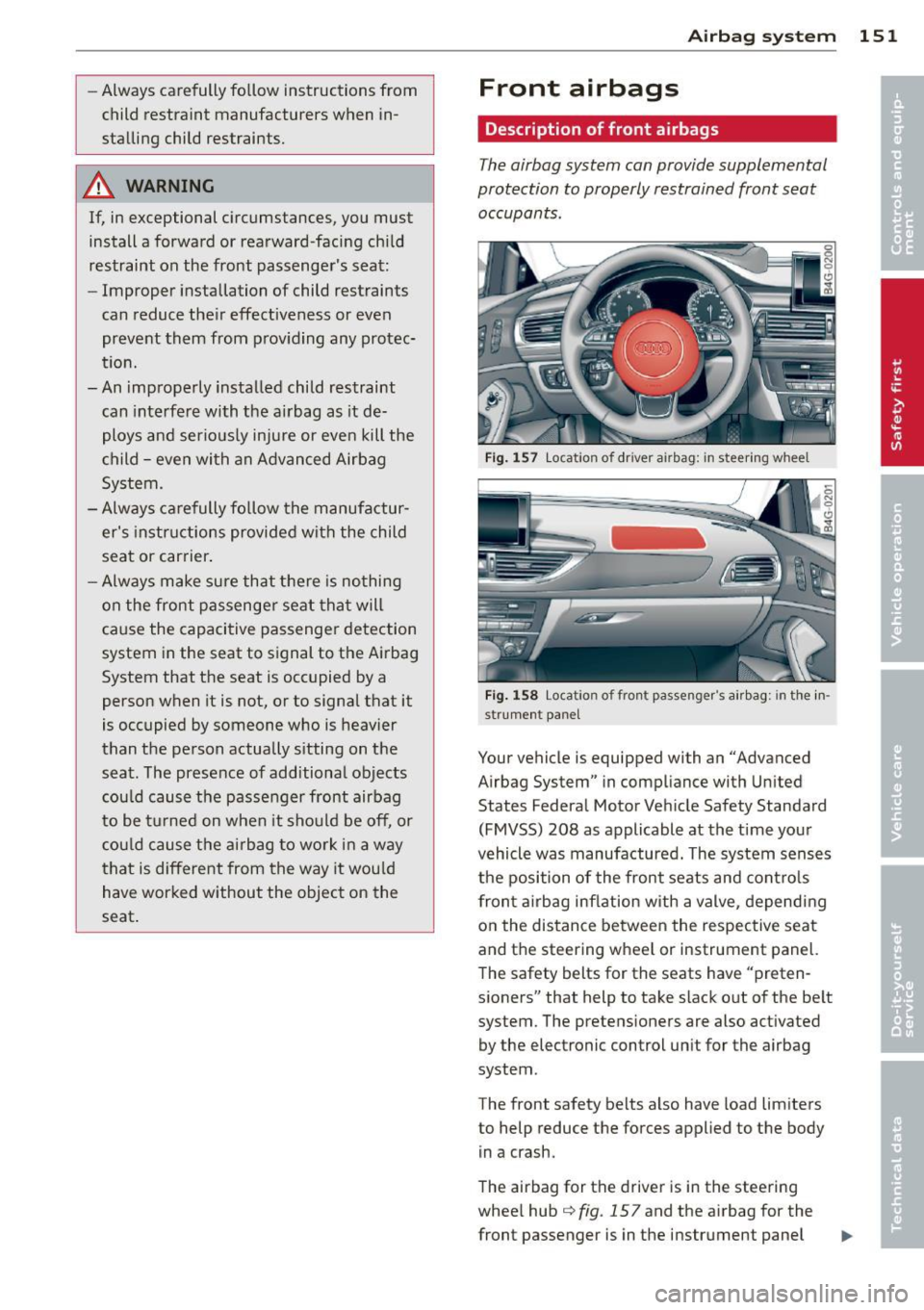
-Always carefully follow instru ctions from
c hild restraint manufacturers when in
sta lling child restraints.
A WARNING
If, in exceptional circumstances, you must
install a forward or rearward-facing child
restraint on the front passenger's seat:
- Improper installation of child restraints
can reduce their effectiveness or even
prevent them from providing any protec
tion.
- An improperly installed child restraint
can interfere with the airbag as it de
ploys and seriously injure or even kill the
child - even with an Advanced Airbag
System.
- Always carefully follow the manufactur
er's instructions provided with the child
seat or carrier .
- Always make sure that there is nothing
on the front passenger seat that will
cause the capacitive passenger detection
system in the seat to signal to the Airbag
System that the seat is occupied by a
person when it is not, or to signal that it
is occupied by someone who is heavier
than the person actually sitting on the
seat. The presence of additional objects
could cause the passenger front airbag
to be turned on when it should be off, or
could cause the airbag to work in a way
that is different from the way it would
have worked without the object on the
seat .
Airbag system 151
Front airbags
Description of front airbags
The airbag system can provide supplemental
protection to properly restrained front seat occupants.
Fig. 157 Loc ation of driver airbag: in steering w heel
Fig. 158 Loc ation of front passenger's a irbag: in the in·
strument panel
Your vehicle is equipped with an "Advanced
Airbag System" in compliance with United
States Federal Motor Vehicle Safety Standard
(FMVSS) 208 as applicable at the time your
vehicle was manufactured. The system senses
the position of the front seats and controls
front airbag inflation with a valve, depending
on the distance between the respective seat
and the steering wheel or instrument panel.
The safety belts for the seats have "preten
sioners" that help to take slack out of the belt
system. The pretens ioners are also activated
by the electronic control unit for the airbag
system .
The front safety belts also have load limiters
to help reduce the forces applied to the body
in a crash.
The airbag for the driver is in the steering
wheel hub
q fig. 157 and the airbag for the
front passenger is in the instrument panel